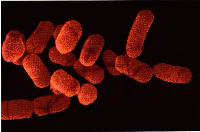Lactobacillus plantarum: Difference between revisions
No edit summary |
|||
| Line 39: | Line 39: | ||
Often isolated from plant material and the gastrointestinal tract of animals. | Often isolated from plant material and the gastrointestinal tract of animals. | ||
Used as a probiotic | |||
http://customprobiotics.com/Merchant2/graphics/00000002/L.-Plantarum-100-gram.jpg | |||
==References== | ==References== | ||
Revision as of 19:28, 18 April 2010
Classification
Firmicutes
Domain: Bacteria; Phylum: Firmicutes; Class: Bacilli; Order:Lactobacillales; family: Lactobacillaceae [Others may be used. Use NCBI link to find]
Species
|
NCBI: Taxonomy |
Lactobacillus plantarum
Description and Significance
L. plantarum is a gram positive bacteria. It is aerotolerant and grows optimally at 15 degrees Celcius.
Genome Structure
Describe the size and content of the genome. How many chromosomes? Circular or linear? Other interesting features? What is known about its sequence?
3,197,759 nt, % Coding: 83% , 3029 genes, circular chromosome,
Cell Structure, Metabolism and Life Cycle
Interesting features of cell structure; how it gains energy; what important molecules it produces.
Ecology and Pathogenesis
Habitat; symbiosis; biogeochemical significance; contributions to environment.
If relevant, how does this organism cause disease? Human, animal, plant hosts? Virulence factors, as well as patient symptoms.
Often isolated from plant material and the gastrointestinal tract of animals.
Used as a probiotic
http://customprobiotics.com/Merchant2/graphics/00000002/L.-Plantarum-100-gram.jpg
References
http://www.ncbi.nlm.nih.gov/sites/entrez?Db=genomeprj&Cmd=Retrieve&list_uids=32969
Author
Page authored by Stephanie LaHaye and Jason McIntyre, student of Prof. Jay Lennon at Michigan State University.

